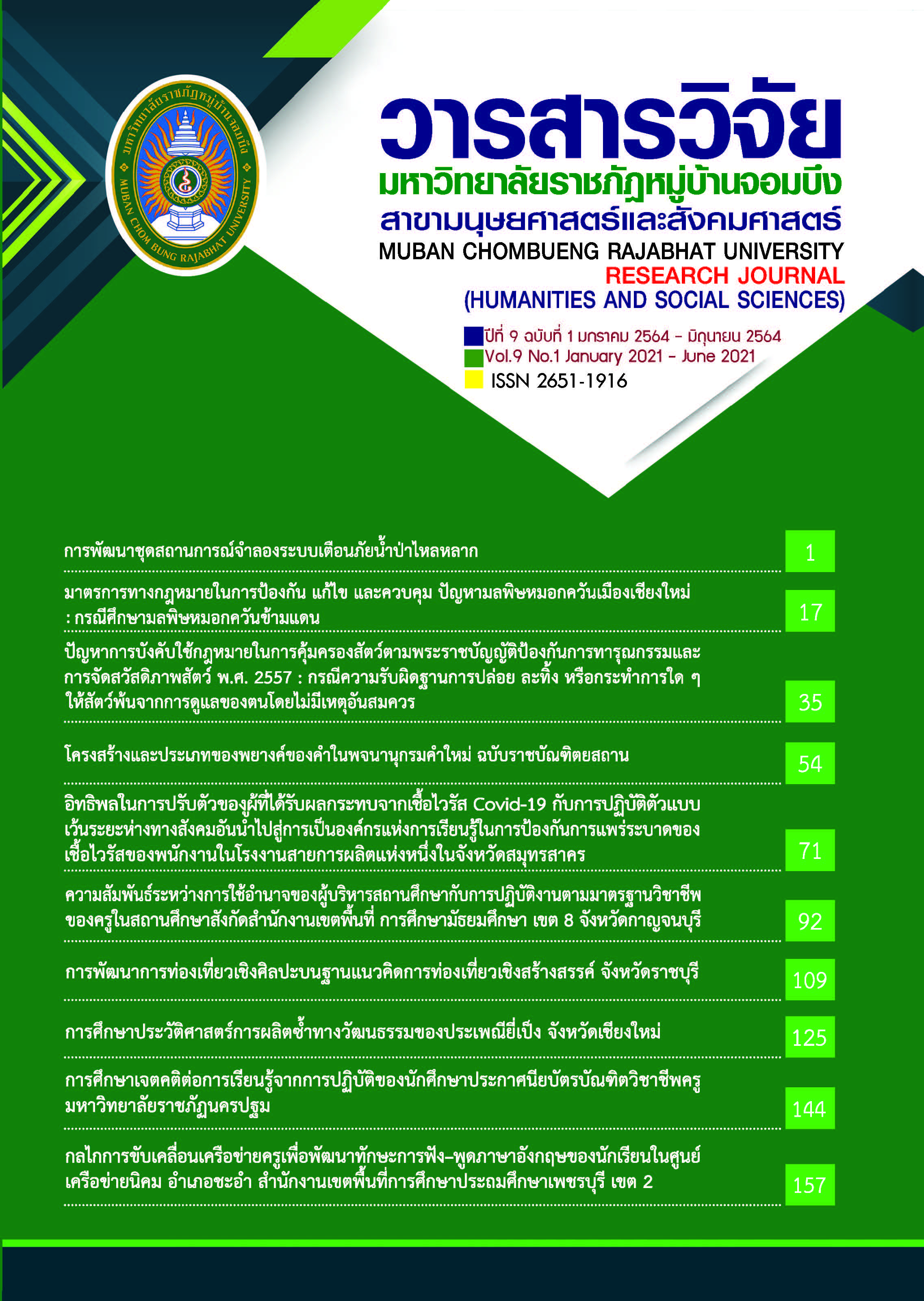โครงสร้างและประเภทของพยางค์ของคำในพจนานุกรมคำใหม่ ฉบับราชบัณฑิตยสถาน
คำสำคัญ:
โครงสร้างพยางค์, ประเภทของพยางค์, คำใหม่บทคัดย่อ
การวิจัยครั้งนี้มีวัตถุประสงค์เพื่อศึกษาโครงสร้างและประเภทของพยางค์ของคำในพจนานุกรมคำใหม่ ฉบับราชบัณฑิตยสถาน โดยมีกลุ่มตัวอย่างทั้งหมด 1,634 คำ ที่สุ่มแบบมีระบบจากพจนานุกรม คำใหม่ ฉบับราชบัณฑิตยสถานทั้งหมด 2 เล่ม และวิเคราะห์ด้วยแนวคิดเรื่อง “โครงสร้างและประเภทของพยางค์” “ประเภทและจุดที่เกิดเสียงพยัญชนะ” และ “ระบบเสียงในภาษาไทย”
ผลการวิจัย พบว่า โครงสร้างและประเภทของพยางค์ของคำจัดกลุ่มตามชนิดของคำประกอบด้วย คำกริยา คำนาม คำวิเศษณ์ ถ้อยคำ คำอุทาน คำลักษณะนาม คำสรรพนาม คำสันธาน คำที่เป็นได้ทั้งคำนามและคำกริยา คำที่เป็นได้ทั้งคำนามและคำวิเศษณ์ และคำที่เป็นได้ทั้งคำกริยาและคำวิเศษณ์ โดยโครงสร้างและประเภทของพยางค์ของคำที่ปรากฏใช้มากที่สุด ได้แก่ คำกริยาในโครงสร้าง “พยางค์ปิด+พยางค์ปิด” ร้อยละ 27.59 และประเภท “พยางค์เป็น+พยางค์เป็น” ร้อยละ 21.11 รองลงมาคือ คำนามในโครงสร้าง “พยางค์ปิด+พยางค์ปิด” ร้อยละ 20.34 และประเภท “พยางค์เป็น+พยางค์เป็น” (20.20) และคำวิเศษณ์ในโครงสร้าง “พยางค์ปิด+พยางค์ปิด” ร้อยละ 34.78 และประเภท “พยางค์เป็น+พยางค์เป็น” ร้อยละ 18.48 ตามลำดับ นอกจากนี้ยัง พบว่า เสียงพยัญชนะท้ายพยางค์ที่ปรากฏมากที่สุด คือ เสียงกัก ร้อยละ 41.00 รองลงมาคือเสียงนาสิก ร้อยละ 39.15 และเสียงเปิด ร้อยละ 19.57 ตามลำดับ
เอกสารอ้างอิง
ชลธิชา บำรุงรักษ์ และนันทนา รณเกียรติ. (2559). ภาษาคืออะไร ใน ดียู ศรีนราวัฒน์. (บรรณาธิการ). ภาษาและภาษาศาสตร์. กรุงเทพฯ: สำนักพิมพ์มหาวิทยาลัยธรรมศาสตร์.
นันทนา รณเกียรติ. (2555ก). การแสดงเพศภาวะด้วยเสียงในชื่อของคนไทย. วารสารภาษาและภาษาศาสตร์, 31(1), 60–80.
นันทนา รณเกียรติ. (2555ข). ทัศนคติการตั้งชื่อเล่นสองพยางค์ของคนไทย. วารสารภาษาและภาษาศาสตร์, 31(1), 1-19.
เปรมฤดี เซ่งยี่. (2557). การศึกษาคำศัพท์ในพจนานุกรมคำใหม่ ฉบับราชบัณฑิตยสถาน. วิทยานิพนธ์ศิลปศาตรมหาบัณฑิต สาขาวิชาภาษาไทย มหาวิทยาลัยศิลปากร.
ปาริชาต สถาปิตานนท์. (2557). ระเบียบวิธีวิจัยการสื่อสาร. กรุงเทพฯ: สำนักพิมพ์แห่งจุฬาลงกรณ์มหาวิทยาลัย.
พรทิพา ทองสว่าง. (2559). ระบบเสียง ใน ดียู ศรีนราวัฒน์. (บ.ก.). ภาษาและภาษาศาสตร์. 67-85. กรุงเทพฯ: สำนักพิมพ์มหาวิทยาลัยธรรมศาสตร์.
พิณทิพย์ ทวยเจริญ. (2547). ภาพรวมของการศึกษาสัทศาสตร์และภาษาศาสตร์. กรุงเทพฯ: สำนักพิมพ์มหาวิทยาลัยธรรมศาสตร์.
รัชตพล ชัยเกียรติธรรม. (2559). การเปรียบเทียบคำยืมภาษาอังกฤษแบบตัด-เพิ่มเสียงพยางคในภาษาไทยและภาษาจีน. วารสารมหาวิทยาลัยราชภัฏมหาสารคาม(มนุษยศาสตร์และสังคมศาสตร์), 10(1536), 73-82.
ราชบัณฑิตยสภา. (2560). พจนานุกรมศัพท์ภาษาศาสตร์ (ภาษาศาสตร์ทั่วไป) ฉบับราชบัณฑิตยสถาน. กรุงเทพฯ: สำนักงานราชบัณฑิตยสภา.
รัตนา จันทร์เทาว์. (2557). คําศัพท์ใหม่ในภาษาลาว. วารสารสังคมลุ่มน้ำโขง, 10(1), 51-70.
พจนานุกรมคำใหม่ 3 ฉบับสำนักงานราชบัณฑิตยสถาน. (2554). กรุงเทพฯ: ยูเนียนอุลตร้าไวโอเร็ต.
พจนานุกรมคำใหม่ 1-2 ฉบับสำนักงานราชบัณฑิตยสถาน. (2557). กรุงเทพฯ: นามมีบุ๊คพับลิเคชั่น.
สุภัทรา โยธินศิริกุล. (2563). ภาษาป้ายชื่อร้านค้าชาวไทยเชื้อสายจีนในเขตชุมชนเยาวราช: กรณีศึกษาชื่อร้านค้าภาษาจีนและภาษาไทย. มนุษยศาสตร์สาร, 21(1), 55-74.
อนงค์นาฏ นุศาสตร์เลิศ. (2556). การออกเสียงพยัญชนะท้าย (l) และ (s) ในคำยืมภาษาอังกฤษในภาษาไทยมาตรฐานของชุมชนหลังมหาวิทยาลัยขอนแก่นตามวัจนลีลาและอายุของผู้พูด. วารสารบัณฑิตศึกษามนุษยศาสตร์และสังคมศาสตร์, 2(1), 15-32.
George Yule. (2017). The Study of Language. Cambridge: Cambridge University Press.
ดาวน์โหลด
เผยแพร่แล้ว
รูปแบบการอ้างอิง
ฉบับ
ประเภทบทความ
สัญญาอนุญาต
วารสาร TCI อยู่ภายใต้การอนุญาต Creative Commons Attribution-NonCommercial-NoDerivatives 4.0 International (CC BY-NC-ND 4.0) เว้นแต่จะรุบุไว้เป็นอย่างอื่นโปรดอ่านหน้านโยบายของเราสำหรับข้อมูลเพิ่มเติมเกี่ยวกับการเช้าถึงแบบเปิด ลิขสิทธิ์ และการอนุญาต



